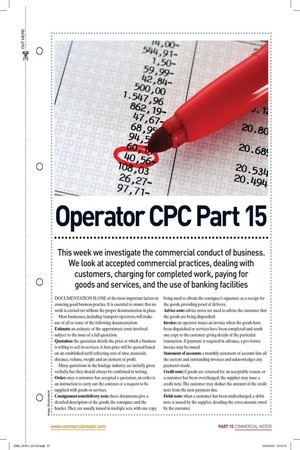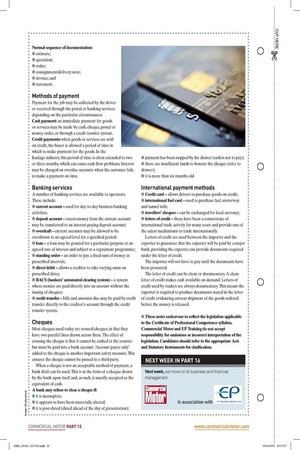Operator CPC Part 15 This week we investigate the commercial
Page 17

Page 18

If you've noticed an error in this article please click here to report it so we can fix it.
conduct of business. We look at accepted commercial practices, dealing with customers, charging for completed work, paying for goods and services, and the use of banking facilities DOCUMENTATION IS ONE of the most important factors in ensuring good business practice. It is essential to ensure that no work is carried out without the proper documentation in place.
Most businesses, including transport operators, will make use of all or some of the following documentation: Estimate: an estimate of the approximate costs involved, subject to the issue of a full quotation.
Quotation: the quotation details the price at which a business is willing to sell its services. A firm price will be quoted based on an established tariff reflecting cost of time, materials, distance, volume, weight and an element of profit.
Many quotations in the haulage industry are initially given verbally, but they should always be confirmed in writing. Order: once a customer has accepted a quotation, an order is an instruction to carry out the contract or a request to be supplied with goods or services.
Consignment note/delivery note: these documents give a detailed description of the goods, the consignee and the haulier. They are usually issued in multiple sets, with one copy being used to obtain the consignee's signature as a receipt for the goods, providing proof of delivery.
Advice note: advice notes are used to advise the customer that the goods are being dispatched.
Invoice: an operator issues an invoice when the goods have been dispatched or services have been completed and sends one copy to the customer giving details of the particular transaction. If payment is required in advance, a pro-forma invoice may be issued.
Statement of accounts: a monthly statement of account lists all the current and outstanding invoices and acknowledges any payments made.
Credit note: if goods are returned for an acceptable reason, or a customer has been overcharged, the supplier may issue a credit note. The customer may deduct the amount of the credit note from the next payment due.
Debit note: when a customer has been undercharged, a debit note is issued by the supplier, detailing the extra amount owed by the customer. Normal sequence of documentation: • estimate; • quotation; • order; • consignment/delivery note; • invoice; and • statement.
Methods of payment Payment for the job may be collected by the driver or received through the postal or banking services, depending on the particular circumstances. Cash payment: an immediate payment for goods or services may be made by cash, cheque, postal or money order, or through a credit transfer system. Credit payments: when goods or services are sold on credit, the buyer is allowed a period of time in which to make payment for the goods. In the haulage industry, this period of time is often extended to two or three months, which can cause cash-flow problems. Interest may be charged on overdue accounts when the customer fails to make a payment on time.
Banking services A number of banking services are available to operators. These include: • current account — used for day-to-day business banking activities; • deposit account — excess money from the current account may be transferred to an interest-paying deposit account; • overdraft — current accounts may be allowed to be overdrawn to an agreed level for a specified period; • loan — a loan may be granted for a particular purpose at an agreed rate of interest and subject to a repayment programme; • standing order — an order to pay a fixed sum of money at prescribed intervals; • direct debit — allows a creditor to take varying sums on prescribed dates; • BACS (bankers' automated clearing system) — a system where monies are paid directly into an account without the issuing of cheques; • credit transfer — bills and amounts due may be paid by credit transfer directly to the creditor's account through the credit transfer system.
Cheques Most cheques used today are crossed cheques, in that they have two parallel lines drawn across them. The effect of crossing the cheque is that it cannot be cashed at the counter but must be paid into a bank account. 'Account payee only' added to the cheque is another important safety measure. This ensures the cheque cannot be passed to a third party.
When a cheque is not an acceptable method of payment, a bank draft can be used. This is in the form of a cheque drawn by the bank upon itself and, as such, is usually accepted as the equivalent of cash.
A bank may refuse to clear a cheque if: • it is incomplete; • it appears to have been materially altered; • it is post-dated (dated ahead of the day of presentation); • payment has been stopped by the drawer (orders not to pay); • there are insufficient funds to honour the cheque (refer to drawer); • it is more than six months old.
International payment methods _ Credit card — allows drivers to purchase goods on credit; • international fuel card — used to purchase fuel, motorway and tunnel tolls; • travellers' cheques — can be exchanged for local currency; • letters of credit — these have been a cornerstone of international trade activity for many years and provide one of the safest mechanisms to trade internationally.
Letters of credit are used between the importer and the exporter to guarantee that the exporter will be paid by a major bank, providing the exporter can provide documents required under the letter of credit.
The importer will not have to pay until the documents have been presented.
The letter of credit can be clean or documentary. A clean letter of credit makes cash available on demand. Letters of credit used by traders are always documentary. This means the exporter is required to produce documents stated in the letter of credit evidencing current shipment of the goods ordered before the money is released.
• These notes endeavour to reflect the legislation applicable to the Certificate of Professional Competence syllabus. Commercial Motor and EP Training do not accept responsibility for omissions or incorrect interpretation of the legislation. Candidates should refer to the appropriate Acts and Statutory Instruments for clarification.







































